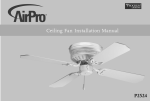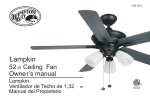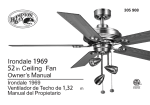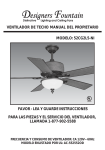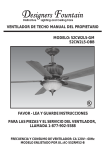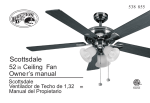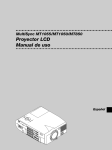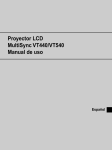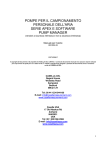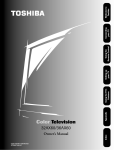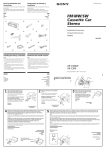Download Progress Lighting P2526-20 Instructions / Assembly
Transcript
PROGRESS LIGHTING 15-Year Limited Warranty PROGRESS LIGHTING FAN MOTORS ARE WARRANTED TO THE END USER TO BE FREE OF ELECTRICAL AND/OR MECHANICAL DEFECTS FOR A PERIOD OF 15 YEARS FROM DATE OF SALE. PULL CHAIN SWITCHES, REVERSE SWITCHES, CAPACITORS AND METAL FINISHES ARE WARRANTED FOR A PERIOD OF 1 YEAR. WARPING OF WOODEN OR PLASTIC BLADES IS NOT COVERED BY THIS WARRANTY. Date Purchased Store Purchased Model No. THE END USER HAS THE OPTION OF RETURNING THE DEFECTIVE FAN TO THE PLACE OF PURCHASE DURING THE FIRST 30 DAYS FOR A REPLACEMENT. AFTER 30 DAYS, THE PURCHASER MUST CONTACT PROGRESS LIGHTING FOR REPAIR OR REPLACEMENT. THE END USER ALSO BEARS THE RESPONSIBILITY FOR ALL COSTS IN THE REMOVAL, SHIPPING AND REINSTALLATION OF FANS OR PARTS FOR REPAIR OR REPLACEMENT. PROGRESS LIGHTING WILL NOT ASSUME LIABILITY OR RESPONSIBILITY FOR DAMAGES (INCLUDING INCIDENTAL OR CONSEQUENTIAL) CAUSED BY THE IMPROPER INSTALLATION OR OPERATION OF THE UNIT OR ITS COMPONENT PARTS, OR BY THE FAILURE OF SUPPORTING HARDWARE NOT SUPPLIED BY PROGRESS LIGHTING. THIS WARRANTY IS GIVEN IN LIEU OF ALL OTHER GUARANTEES, WHETHER EXPRESSED OR IMPLIED, AND IS VOIDED IN CASES OF ABUSE, MISUSE OR IMPROPER HANDLING, NEGLIGENCE, SHIPPING DAMAGE, UNAUTHORIZED REPAIRS (MADE OR ATTEMPTED) OR UNUSUAL APPLICATION. Serial No. Vendor No. UPC 11221 785247139217 SOME STATES DO NOT ALLOW LIMITATIONS ON HOW LONG AN IMPLIED WARRANTY LASTS OR THE EXCLUSION OR LIMITATIONS OF INCIDENTAL OR CONSEQUENTIAL DAMAGES, SO THE ABOVE LIMITATIONS AND EXCLUSIONS MAY NOT APPLY TO YOU. THIS WARRANTY GIVES YOU SPECIFIC RIGHTS AND YOU MAY HAVE OTHER RIGHTS WHICH VARY FROM STATE TO STATE. 15-Year Limited Warranty Safety Rules..................................................................................................................................... 1. Unpacking Your Fan ........................................................................................................................ 2. Installing Your Fan ........................................................................................................................... 3. Operating Your Fan ........................................................................................................................ 10. Care of Your Fan ............................................................................................................................ 11. Troubleshooting ............................................................................................................................ 12. Specifications ............................................................................................................................... 13. Table of Contents 1. To reduce the risk of electric shock, insure electricity has been turned 9. off at the circuit breaker or fuse box before beginning. 10. 2. All wiring must be in accordance with the National Electrical Code and local electrical codes. Electrical installation should be performed by a qualified licensed electrician. 11. 3. WARNING: To reduce the risk of electrical shock and fire, do not use this fan with any solid-state fan speed control device. 12. 4. WARNING: To reduce the risk of personal injury, use only the two steel screws (and lock washers) provided with the outlet box for mounting to the outlet box. Most outlet boxes commonly used for the support of lighting fixtures are not acceptable for fan support and may need to be replaced, consult a qualified electrician if in doubt. 13. WARNING TO REDUCE THE RISK OF FIRE, ELECTRIC SHOCK OR PERSONAL INJURY, MOUNT FAN TO OUTLET BOX MARKED ACCEPTABLE FOR FAN SUPPORT. 5. The outlet box and support structure must be securely mounted and capable of reliably supporting a minimum of 50 pounds. Use only UL Listed outlet boxes marked FOR FAN SUPPORT. 6. The fan must be mounted with a minimum of 7 feet clearance from the trailing edge of the blades to the floor. 7. WARNING: Use only with light kit marked "Suitable for Use in Damp Locations" . 8. Do not operate reversing switch while fan blades are in motion. Fan must be turned off and blades stopped before reversing blade direction. 1. Safety Rules Avoid placing objects in the path of the blades. To avoid personal injury or damage to the fan and other items, be cautious when working around or cleaning the fan. Do not use water or detergents when cleaning the fan or fan blades. A dry dust cloth or lightly dampened cloth will be suitable for most cleaning. After marking electrical connections, spliced conductors should be turned upward and pushed carefully up into outlet box. The wires should be spread apart with the grounded conductor and the equipment-grounding conductor on one side of the outlet box. Electrical diagrams are reference only. Light kit that are not packed with the fan must be UL Listed and marked suitable for use with the model fan you are installing. Switches must be UL General Use Switches. Refer to the Instructions packaged with the light kits and switches for proper assembly. WARNING TO REDUCE THE RISK OF PERSONAL INJURY, DO NOT BEND THE BLADE BRACKETS (ALSO REFERRED TO AS FLANGES) DURING ASSEMBLY OR AFTER INSTALLATION. DO NOT INSERT OBJECTS IN THE PATH OF THE BLADES. WARNING THIS PRODUCT CONTAINS CHEMICALS KNOWN TO THE STATE OF CALIFORNIA TO CAUSE CANCER, BIRTH DEFECTS AND /OR OTHER REPRODUCTIVE HARM. THOROUGHLY WASH HANDS AFTER INSTALLING, HANDLING, CLEANING, OR OTHERWISE TOUCHING THIS PRODUCT. NOTE READ AND SAVE ALL INSTRUCTIONS! 2 1 6 9 3 a 4 b 7 10 5 8 11 c d Unpack your fan and check the contents. You should have the following items: 11. Loose parts bag containing: 1. Set of blades (5) 2. Mounting plate (located inside canopy) 3. Canopy assembly 4. Ball/downrod assembly with safety cable a. Blade attachment hardware (16 screws, 16 rubber washers) b. Blade bracket attachment hardware (1 screws with lock washers) c. Mounting hardware (3 screws, 1 plastic gasket, 1 metal gasket) d. Electrical hardware (3 plastic wire connectors, 1 Pull chain) 5. Coupling cover 6. Fan motor assembly 7. Set of blades bracket (5) 8. Mounting plate 9. Switch housing 10. Balancing kit IMPORTANT PLEASE REMOVE RUBBER MOTOR SUPPORT PLATE ON THE BOTTOM OF THE FAN BEFORE INSTALLING BLADES OR TESTING MOTOR Unpacking Your Fan 2. Tools Required Figures 1,2 and 3 are examples of different ways to mount the outlet box. Phillips screw driver, straight slot screw driver, adjustable wrench, step ladder, and wire cutters. Provide strong support Ceiling Mounting Plate Recessed outlet box Mounting Options If there isn't an existing UL listed mounting box, then read the following instructions. Disconnect the power by removing fuses or turning off circuit breakers. Secure the outlet box directly to the building structure. Use appropriate fasteners and building materials. The outlet box and its support must be able to fully support the moving weight of the fan (at least 50 lbs). Do not use plastic outlet Angled ceiling maximum 45 angle Outlet box Figure 3 Note: You may need a longer downrod to maintain proper blade clearance when installing on a steep, sloped ceiling. Figure 1 WARNING TO REDUCE THE RISK OF FIRE, ELECTRIC SHOCK, OR OTHER PERSONAL INJURY, MOUNT FAN ONLY TO AN OUTLET BOX MARKED ACCEPTABLE FOR FAN SUPPORT AND USE THE MOUNTING SCREWS PROVIDED WITH THE OUTLET BOX. OUTLET BOXES COMMONLY USED FOR THE SUPPORT OF LIGHTING FIXTURES MAY NOT BE ACCEPTABLE FOR FAN SUPPORT AND MAY NEED TO BE REPLACED. CONSULT A QUALIFIED ELECTRICIAN IF IN DOUBT. Figure 4 Outlet box Figure 2 3. Installing Your Fan Outlet box To hang your fan where there is an existing fixture but no ceiling joist, you may need an installation hanger bar as shown in Figure 4 (available at your Progress Lighting Hanging the Fan REMEMBER to turn off the power. Follow the steps below to hang your fan properly. NOTE: This ceiling fan is supplied with two types of hanging assemblies; the standard ceiling installation using the ball/ downrod assembly mounting, and the "close-toceiling" mounting. The "close-to-ceiling" mounting is recommended in rooms with less than 8-foot ceilings or in areas where additional space is desired from the floor to the fan blades. When using standard downrod installation, the distance from the ceiling to the bottom of the fan blades will be approximately 14.5 inches. The "close-toceiling" installation reduces the distance from the ceiling to the bottom of the fan blades to approximately 9 inches. Standard ceiling mounting Note: For mounting angles between 20-45 degrees, remove the canopy bottom cover installed on the bottom of the canopy. 1. Remove the canopy ring from the canopy. (Figure 5). Pin in locked position Motor wires Ball/downrod assembly Canopy ring Ceiling canopy Canopy ring Figure 5 Collar cover 2. Remove the mounting plate from the canopy by loosening the four screws on the top of the canopy. Remove the two nonslotted screws and loosen the slotted screws. This will enable you to remove the mounting plate (Figure 6). Tighten screws firmly Motor collar Hanger pin Locking pin Loosen but do not remove Figure 7 Remove Figure 6 3. Remove the bolt, lock pin and loosen set screws from the top of the motor assembly. 4. Route the wires exiting the top of the fan motor through the decorative motor collar cover then the canopy ring. Make sure the slot openings are on top. Route the wires through the canopy and then through the ball/downrod assembly (Figure 7). 5. Loosen, but do not remove, the set screws on the collar on the top of the motor housing. 6. Align the holes at the bottom of the downrod with holes in the collar on top of the motor housing (Figure 7). Carefully insert the hanger pin through the holes in the collar and downrod. Be careful not to jam the pin against the wiring inside the downrod. Insert the locking pin through the hole near the end of the hanger pin until it snaps into its locked position as noted in the circle inset of Figure 7. 7. Re-tighten the set screws on the collar on the top of the motor housing. WARNING FAILURE TO PROPERLY INSTALL LOCKING PIN AS NOTED IN STEP 6 COULD RESULT IN FAN LOOSENING AND POSSIBLY FALLING. 4. Close-to-Ceiling Mounting 1. Remove the canopy ring from the canopy. (Figure 5) 2. Remove the mounting plate from the canopy by loosening the four screws on the top of the canopy. Remove the two nonslotted screws and loosen the slotted screws. This will enable you to remove the mounting plate (Figure 7). 3. Remove the decorative canopy bottom cover from the canopy by depressing the three studs (Figure 8). 4. Remove the bolt, lock pin and set screws from the top of the motor assembly. Canopy bottom cover Figure 8 5. Remove three of six screws and lock washers (every other one) securing the motor collar to the top of the fan motor housing. (Figure 9). Motor collar Screw with lock washer (3 of 6 places) Metal gasket Ceiling Canopy Figure 9 6. Route the wires exiting the top of the fan motor through the plastic gasket, canopy ring, canopy and the metal gasket, place the plastic gasket over the remaining three screws, place the canopy ring, canopy and the metal gasket over the motor collar at the top of the fan motor (Figure 10). 7. Align the three mounting screw holes on the metal gasket with the holes on the motor collar at the top of the fan motor and fasten, using the three screws and lock washers provided with metal gasket. 8. Tighten the three mounting screws securely. 5. Screw with lock washer Canopy ring Plastic gasket Figure 10 Installing Fan to the Electrical Box The outlet box and support structure must be securely mounted and capable of reliably supporting a minimum of 50 pounds. use only cul listed outlet boxes marked"Acceptable for Fan Support of 22.7 kgs (50 lbs) or less". 1. Pass the 120-volt supply wires through the center hole in the ceiling mounting plate as shown in Figure 11. 2. Install the ceiling mounting plate on the electrical box by mounting screws provided with the outlet box. When using close-to-ceiling mounting, it is important that the mounting plate be level. If necessary, use leveling washers (not supplied) between the mounting plate and electrical box. Note that the flat side of the mounting plate is toward the electrical box (Figure 11). 3. Securely tighten the two mounting screws. CUL Listed electrical box Ceiling mounting plate Washers 120V Wires Figure 11 Mounting screws (supplied with electrical box) 4. For additional security, install the wood screws with flat washers (not included) through outer slots in mounting plate and into wooden joist. Note: Leave one wood screw untightened to attach safety cable from motor (Figure 12). Ceiling Close- to-Ceiling Mounting Standard Mounting Wood joist Outlet box Figure 13 Figure 13-1 Figure 12 5. Carefully lift the fan assembly up to the ceiling mounting plate and hang the fan on the hook under the following two ways: for Close-to-Ceiling Mounting; utilizing one of the holes at the outer rim of the ceiling canopy (Figure 13), for Standard Mounting; place the looped end of the safety cable out of hanging ball around the hook on the ceiling mounting plate. (Figure 13-1) WARNING THE HOOK AS SHOWN IN FIG. 13 IS ONLY TO BALANCE FAN WHILE CONNECTING WIRING. FAILURE TO HANG AS SHOWN IN FIG. 13 MAY RESULT IN HOOK BREAKING CAUSING THE FAN TO FALL. HOOK MUST PASS FROM INSIDE TO OUTSIDE OF CANOPY. THE ILLUSTRATION SHOWN IN FIGURE 13-1 IS ONLY TO PROVIDE A MEANS TO BALANCE THE FAN WHILE ATTACHING WIRING. FAILURE TO COMPLETE INSTALLATION ACCORDING TO THIS MANUAL WILL RESULT IN DAMAGE TO PROPERTY AND PERSONAL INJURY. 6. Step 1 Connect the fan supply (black) wire and light supply (blue) wire to the black household supply wire as shown in Figure 14. Step 4 After connecting the wires, spread them apart so that the green and white wires are on one side of the outlet box and the black wire is on the other side. 7. Ground Conductor Outlet Box WARNING ELECTRICAL DIAGRAMS ARE FOR REFERENCE ONLY. OPTIONAL USE OF ANY LIGHT KIT SHALL BE CUL LISTED AND MARKED SUITABLE FOR USE WITH THIS FAN. Step 2. Connect the neutral fan (white) wire to the white neutral household wire. Step 3 Connect the two green fan ground wires, located on the hanging ball and mounting plate, to the household ground wire. When using Close-toCeiling mounting, there is only one green ground lead from the ceiling mounting plate since the ball/downrod assembly is not used. WHITE BLACK WARNING TO REDUCE THE RISK OF FIRE OR ELECTRIC SHOCK, DO NOT USE A WALL MOUNTED SOLID STATE SPEED CONTROL WITH THIS FAN. IT WILL PERMANENTLY DAMAGE THE ELECTRONIC CIRCUITRY. GREEN Follow the steps below to connect the fan to your household wiring. Use the wire connecting nuts supplied with your fan. Secure the connectors with electrical tape. Make sure there are no loose strands or connections. SUPPLY CIRCUIT WHITE REMEMBER to disconnect the power. If you feel that you do not have enough electrical wiring knowledge or experience, have your fan installed by a licensed electrician. Step 5 Turn the connecting nuts upward and push the wiring into the outlet box. BLUE BLACK Making the Electrical Connections BLUE BLACK Green Ground Lead Ground to Downrod WHITE WHITE Figure 14 Diagram indicates optional light kit wiring. Finishing the Installation Attaching the Fan Blades 1. Carefully unhook the fan from the mounting plate, for Standard Mounting; you can keep the cable around the hook and seat the hanger ball in canopy, make sure the tab in the ring at the bottom of the canopy is properly seated in the groove in the hanger ball. Align the locking slots of the ceiling canopy with the two screws in the mounting plate. Push up to engage the slots and turn clockwise to lock in place. Immediately tighten the two mounting screws firmly. NOTE: Your fan blades are reversible. Select the blade side finish which best accentuates ' ' your decor. 2. Install the remaining two mounting screws into the holes in the canopy and tighten firmly. Step 2 Tighten each screw securely starting with the center screw. Make sure the blade is straight. Rubber washer Figure 15 Step 1 Attach the blades to the blade arms using three screws and rubber washers as shown in Figure 15. Start a screw into the arm, do not tighten. Repeat for the 2 remaining screws and washers. 3. Install the decorative canopy ring by aligning the ring's slots with the screws in the canopy. Rotate the ring counter-clockwise to lock in place. Step 3 Fasten the blade assembly to the motor using the motor screws provided. (Figure 16) 4. You may now proceed to attaching the fan blades. Step 4 Install an optional light kit if you wish. Follow the instructions included with the kit. WARNING LOCKING SLOTS OF CEILING CANOPY ARE PROVIDED ONLY AS AN AID TO MOUNTING. DO NOT LEAVE FAN ASSEMBLY UNATTENDED UNTIL ALL FOUR CANOPY SCREWS ARE ENGAGED AND FIRMLY TIGHTENED. Screws Blade arm Blade Motor Blade arm Figure 16 8. Installing the Mounting Installing the Switch Plate Housing Step 1. Remove 1 of the 3 screws from the mounting ring and loosen the other 2 screws. (Do not remove) Step 2. Place the key holes on the mounting plate over the 2 screws previously loosened from the mounting ring, turn mounting plate until it locks in place at the narrow section of the key holes. Secure by tightening the 2 screws previously loosened and the one previously removed. (Fig. 17) NOTE: Before starting installation, disconnect the power by turning off the circuit breaker or removing the fuse at fuse box. Turning power off using the fan switch is not sufficient to prevent electric shock. 1. Remove the screws from the mounting plate under the fan motor. 2. While holding the switch housing under your fan, snap together the wire connection plug. (Fig. 18) 3. Raise the switch housing to the mounting plate until the holes in switch housing and mounting plate line up. Reinsert screws to secure in place. (Fig. 18) Connection plug Switch housing Figure 18 Mounting ring Mounting plate Figure 17 9. Screws Mounting ring Screws Blade blancing All blades are grouped by weight. Because natural woods very in density, the fan may wobble even though the blades are weighed equally. WARNING TO REDUCE THE RISK OF PERSONAL INJURY, DO NOT BEND THE BLADE HOLDERS WHILE INSTALLING, BALANCING THE BLADES, OR CLEANING THE FAN. DO NOT INSERT FOREIGN OBJECTS BETWEEN ROTATING FAN BLADES. The following procedure should correct most fan wobbling problems. Check after each step. Touching ceiling 1. Check that all blade and blade arm screws are secure. 2. Most fan wobbling problems are caused when blade levels are unequal. Check this level by selecting a point on the ceiling above the tip of one of the blades. Measure this distance as shown in Figure 19. Rotate the fan until the next blade is positioned for measurement. Repeat for each blade. The distance deviation should be equal within 1/8". 3. Use the enclosed Blade Balancing Kit if the blade wobble is still noticeable. NOTE WAIT FOR FAN TO STOP BEFORE CHANGING THE SETTING OF THE SLIDE SWITCH. Turn on the power and check the operation of your fan. There are two pull chains available in your fan: 1. 3-speed pull chain- it controls the fan speed as follows: 1 pull- High, 2 pulls- Medium, 3 pullsLow, and 4 pulls- Off. Speed settings for warm or cool weather depend on factors such as the room size, ceiling height, number of fans, and so on. Figure 19 The slide switch controls directions: forward (switch left) or reverse (switch right). Warm weather - (Forward) A downward air flow creates a cooling effect as shown in Figure 20. This allows you to set your air conditioner on a higher setting without affecting your comfort. Cool weather - (Reverse) An upward airflow moves warm air off the ceiling area as shown in Figure 21. This allows you to set your heating unit on a lower setting without affecting your comfort. 4. If the blade wobble is still noticeable, interchanging two adjacent (side by side) blades can redistribute the weight and possibly result in smoother operation. Operating Your Fan 10. Here are some suggestions to help you maintain your fan 1.Because of the fan's natural movement, some connections may become loose. Check the support connections, brackets, and blade attachments twice a year. Make sure they are secure. (It is not necessary to remove fan from ceiling.) Figure 20 2. Clean your fan periodically to help maintain its new appearance over the years. Use only a soft brush or lint-free cloth to avoid scratching the finish. The plating is sealed with a lacquer to minimize discoloration or tarnishing. Do not use water when cleaning. This could damage the motor, or the wood, or possibly cause an electrical shock. Figure 21 11. Care of Your Fan 3. You can apply a light coat of furniture polish to the wood blades for additional protection and enhanced beauty. Cover small scratches with a light application of shoe polish. 4. There is no need to oil your fan. The motor has permanently lubricated bearings. IMPORTANT MAKE SURE THE POWER IS OFF AT THE ELECTRICAL PANEL BOX BEFORE YOU ATTEMPT ANY REPAIRS. REFER TO THE SECTION "MAKING ELECTRICAL CONNECTIONS" Problem Solution Fan will not start. 1.Check circuit fuses or breakers. 2. Check line wire connections to the fan and switch wire connections in the switch housing. CAUTION: Make sure main power is off. Fan sounds noisy. 1. Make sure all motor housing screws are snug. 2. Make sure the screws that attach the fan blade bracket to the motor hub is tight. 3. Make sure wire nut connections are not rubbing against each other or the interior wall of the switch housing. CAUTION: Make sure main power is off. 4. Allow a 24-hour "breaking-in" period. Most noise associated with a new fan disappear during this time. 5. If using an optional light kit, make sure the screws securing the glassware are tight. Check that light bulb is also secure. 6.Some fan motors are sensitive to signals from solid-state variable speed controls. If you have installed this type of control, choose and install another type of control. 7. Make sure the upper canopy is a short distance from the ceiling. It should not touch the ceiling. Troubleshooting 12. Fan Size 52" Speed Volts Amps Watts RPM CFM Low 120 0.28 17 64 1510 Medium 120 0.43 38 118 2766 High 120 0.59 70 170 4150 These are approximate measures. They do not include Amps and Wattage used by the light kit. C 2007 Progress Lighting, Inc. 701 Millennium Blvd Greenville, SC 29607 All Rights Reserved 13. Specifications N.W. G.W. C.F. 11.64 kgs 13.2 kgs 2.37' Garantía Limitada de 15 Años LOS VENTILADORES PROGRESS LIGHTING GARANTIZAN AL CONSUMIDOR ESTAR LIBRES DE DEFECTOS ELÉCTRICOS Y/O MECÁNICOS PRO UN PERÍODO DE 15 AÑOS A PARTIR DE LA FECHA DE VENTA. LOS INTERRUPTORES CON CADENA, LOS INTERRUPTORES DE INVERSIÓN. LOS CONDENSADORES Y LAS TERMINACIONES METÁLICAS ESTÁN GARANTIZADAS POR UN PERÍODO DE 1 AÑO. LAS PALETAS PANDEADAS DE MADERA O PLÁSTICO NO ESTÁN CUBIERTAS POR ESTA GARANTÍA. EL CONSUMIDOR TIENE LA OPCIÓN DE DEVOLVER EL VENTILADOR DEFECTUOSO PARA SU CAMBIO AL NEGOCIO DE ADQUISICIÓN DURANTE LOS 30 DÍAS SIGUIENTES. DESPUÉS DE 30 DÍAS, EL COMPRADOR DEBE CONTACTAR PROGRESS LIGHTING PARA LA REPARACIÓN O REEMPLAZO. EL CONSUMIDOR SE HARÁ CARGO DE TODOS LOS COSTOS DE TRANSPORTE, EXPEDICIÓN Y REINSTALACIÓN DE LOS VENTILADORES O DE LAS PARTES PARA REPARAR O REEEMPLAZAR. PROGRESS LIGHTING NO ASUMIRÁ OBLIGACIONES O RESPONSABILIDAD POR DAÑOS (INCLUYENDO INCIDENTALES O CONSIGUIENTES) CAUSADOS POR EL USO O LA INSTALACIÓN IMPROPIA DE LA UNIDAD O DE SUS PARTES COMPONENTES, O POR LA FALLA DEL EQUIPO DE SOPORTE NO SUMINISTARADO POR PROGRESS LIGHTING ESTA GARANTÍA ESTÁ DADA EN LUGAR DE TODAS LAS OTRAS GARANTÍAS, SEAN ÉSTAS EXPRESAS O IMPLÍCITAS, Y ES INVÍCIDA EN CASOS DE ABUSO, USO O MANEJO INCORRECTOS, TRATAMIENTO NEGLIGENTE, DAÑOS OCASIONADOS POR EL TRANSPORTE, REPARACIONES NO AUTORIZADAS (REALIZADAS O TENTATIVAS) O APLICACIÓN INUSUAL. Fecha de compra Lugar de compra N de modelo. N de serie Numero de vendedor UPC 11221 785247139217 ALGUNOS ESTADOS NO RECONOCEN LIMITACIONES EN EL TÉRMINO DE LA GARANTÍA IMPLICADA O LA EXCLUSIÓN O LIMITACIÓN DE LOS DAÑOS INCIDENTALES O CONSIGUIENTES, ENTONCES LAS LIMITACIONES Y EXCLUSIONES PRECEDENTES PUEDEN NO SER APLICABLES A UD. ESTA GARANTÍA LE OTORGA DERECHOS ESPECÍFICOS Y UD. PUEDE TENER OTROS DERECHOS QUE VARÍEN DE ESTADO EN ESTADO. Garantía Limitada de 15 Años Normas de seguridad ...................................................................................................................................................................... 1. Cómo desembalar el ventilador ...................................................................................................................................................... 2. Cómo instalar el ventilador ............................................................................................................................................................ 3. Operando su transmisor ..............................................................................................................................................................10. Cómo cuidar del ventilador .......................................................................................................................................................... 11. Resolución de problemas ............................................................................................................................................................. 12. Especificaciones ........................................................................................................................................................................... 13. Tabla de Contenido 1. Para reducir el riesgo de eléctrocución, asegurarse de que la eléctricidad se ha desactivado en el cortacircuitos o caja de fusibles antes de comenzar. 2. Todo cableado debe relizarse conforme al Código Electrico Nacional y los códigos electricos locales. La instalación eléctrica debe ser relazada por un eléctricista registrado calificado. 3. ADVERTENCIA: Para reducir el riesgo de una electrocuion e incendio, no usar este ventilador con ningun dispositivo de esto s lido para control de la velocidad del ventilador. 4. ADVERTENCIA: Para reducir el riesgo de daños personales, utilice sólo los dos tornillos de acero (y arandelas de bloqueo) suministrados en la caja del enchufe para el montaje en ésta. La mayoría de cajas de enchufes usadas comúnmente para instalaciones de luz no sirven para soportar un ventilador y puede que necesite cambiarlas; si tiene dudas, consulte con un electricista cualificado. ADVERTENCIA PARA REDUCIR EL RIESGO DE INCENDIO ELECTROCUCIÓN O LESIONES PERSONALES. MONTAR EL VENTILADOR EN UNA CAJA DE DISTRIBUCIÓN MARCADA CÓMO ACEPTABLE PARA SOPORTE DE VENTILADORES. 5. La caja de distribución y la estructura de soporte deben estar montados de manera segura y deben ser capaces de soportar, de manera confiable, unminimo de 35 libras (15.9 kilogramos). Usar solamente cajas de distribución listadas por U.L. marcadas "PARA SOPORTEDE VENTILADORES". 6. EL ventilador debe estar montado con un m nimo de 7 pies (213cm) de espacio libre desde el borde posterior de las aspas hasta el piso. 7. ADVERTENCIA: Utilice solamente con "conveniente marcada kit ligero para el uso en localizaciones húmedas". 8. No operar el conmutador inversor mientras las aspas del ventilador están en movimiento. EI ventilador debe estar desacivado y las aspas estáticas antes de invertir la dirección de la aspas. 1. Normas de seguridad 9. Evitar colocar objetos qen interfiera el giro de las aspas. 10. Para evitar lesiones personales o da os al ventilador y otros articulos, tener cuidado al trabajar cerca del ventilador o al limpiarlo. 11. No usar agua o detergentes al limpiar el ventilador o las aspas del ventilador. Para la mayoria de los propsitos de limpieza, un paño seco o ligeramente humedecido será apropiado. 12. Despues de realizar las conexiones eléctricas, los conductores empalmados se deben voltear hacia arriba y se deben empujar con cuidado hacia dentro de la caja de distribución. Los cables deben estar separados, con el conductor a tierra y el conductor a tierra del equipo en un lado de la caja de distribución. 13. Los diagramas eléctricos son para referencia únicamente. Los juegos de iluminación que no estén embalados con el ventilador deben estar Listados por U.L. y marcados como apropiados para ser usados con el modelo de ventilador que se está instalando. Los interruptores deberán ser Interruptores para uso general U.L. Réfierase a las instrucciónes embaladas con los juegos de iluminación e interruptores para obtener información sobre el montaje adecuado. ADVERTENCIA ESTE PRODUCTO CONTIENE SUBSTANCIAS QUÍMICAS QUE SEGÚN EL ESTADO DE CALIFORNIA CAUSA CÁNCER, DEFECTOS DE NACIMIENTO Y (O) DAÑO AL SISTEMA REPRODUCTOR. LAVARSE BIEN LAS MANOS DESPUÉS DE INSTALAR, MANIPULAR, LIMPIAR O TOCAR DE MANERA ALGUNA ESTE PRODUCTO. ADVERTENCIA PARA REDUCIR EL RIESGO DE LESIONES PERSONALES, NO DOBLAR LOS SOPORTES DE LAS ASPAS (TAMBIEN LLAMADOS"REBORDES" DURANTE EL MONTAJE O DESPUES DE LA INSTALACIÓN NO INSERTAR OBJETOS EN LA TRAYECTORIA DE LAS ASPAS. NOTA !LEER Y GUARDAR TODAS LAS INSTRUCCIONES! 2 1 6 9 3 a b 7 4 10 8 5 11 c d Desembalar el ventilador y revisar el contenido. Debe tener los siguientes elementos: 1. Juego de aspas (5) 2. Placa de montaje (Localizada dentro del escudete) 3. Escudete 4. Conjunto de bola/tubo de suspension 5. Cubridor del motor 6. 7. 8. 9. 10. Conjunto de motor del ventilador. Juego de soporte de fijación a aspas (5) Plato de montaje Caja del interruptor Juego de balanceo 12. Dos bolsas de piezas pequeñas: a. Piezas de fijacion de las aspas (16 tornillos, 16 arandelas de goma ) b. Piezas de fijación de los soporte de pala (11 tornillos con arandelas de cierre) c. Piezas demontaje (3 tornillos, 1 junta de metal, 1 junta de goma) d. Empacadura de goma (3 conectores plasticos para cables) electricos, 2 Tirador para ventilador) Cómo desembalar el ventilador 2. Herramienta necesarias Angulo máximo en el techo: 45° Destornillador Phillips, destornillador normal, llave de tuercas ajustable, escalera de tijera, y cortadoras de alambre. Opciones de instalación Soportede Montajeen el Techo Caja de Distribución Recedida Si no hay una caja con UL registración de montaje existente, sirvase leer las siguientes instrucciones. Desconectar el suministro de electricidad removiendo los fusibles o desactivando los cortacircuitos. Asegurar la caja de distribución directamente a la estructura del edificio. Usar los sujetadores y meteriales de construcción apropiados. La caja de distribución y su soporte deben ser capaces de soportar completamente el peso en movimiento del ventilador (al menos 50 libras o 22.7 kgs.)No usar cajas de distribución plásticas. Proveer Soporte Fuerte Caja de Distribución Figura 3 Figura 1 Nota: Ud. Puede necesitar una barra de extension para mantener la distancia apropiada de las aspas cuando la instalación se efectúe en un techo inclinado. Las figuras 1,2 y 3 son ejemplos de diferentes maneras de montar la caja de distribución. ADVERTENCIA PARA REDUCIR EL RIESGO DE INCENDIO, ELECTROCUCIÓN O DAÑO PERSONAL, INSTALAR EL VENTILADOR A UNA CAJA DE DISTRIBUCION MARCADA "ACEPTADA PARA SOPORTAR VENTILADOR" Y USAR LOS TORNILLOS DE MONTAJE SUMINISTRADOS CON LA CAJA DE DISTRIBUCION Caja de Distribución Figura 2 3.Cómo instalar el ventilador Figura 4 Caja de distribución Para colgar su ventilador donde ya existe una instalación pero no una viga de techo, es possible que se necesite una instalación de barra de suspención como se muestra la Figura 4 (disponible en su distribuidor Progress Lighting). Colgando el Ventilador RECORDAR cortar el suministro de energía eléctricia. Seguir los pasos siguientes para colgar su ventilador apropiadamente. NOTA: Este ventiladores suministrado con dos métodos diferentes para ser colgado; el método estandar que incluye el tubo descendiente con montaje de bola y receptáculo y el montaje "próximo al techo". El método "próximo al techo", se recomienda para habitaciones con menos de 8 pies de altura o en areas donde se requiera mayor distancia entre el piso y las aspas del ventilador. Al usar el método estandar de montaje con tubo, la distáncia entre el techo y la parte más baja de las aspas deberá ser aproximadamente 14.5 pulgadas. El método "próximo al techo" reduce esta distancia a 9 pulgadas. Cables del motor Anillo decorativo Conjunto de bola/tubo de suspensión Escudete para el techo Anillo decorativo Chaveta en la posición asegurada Figura 5 Cubridor del motor 2. Retire la placa de montaje de la marquesina desenroscando los cuatro tornillos ubicados en la parte superior de la marquesina. Retire los dos tornillos de cabeza sin ranura y desenrosque los tornillos de cabeza con ranura. Asi se podrá retirar la placa de montaje (Figura 6). Soltar pero NO remover Collain del motor Pasador de suspensión Apretar los tornillors confimeza Chavetar de seguridad Figura 7 6. Alinee los agujeros de la parte inferior del tubo con los agujeros del aro en la parte superior de la cubierta del motor (Figura 7). Introduzca con cuidado el pasador Metodo estándar demontaje a través de los agujeros del aro y del tubo. Tenga cuidado de no empujar el pasador contra los alambres Nota: Para ángulos de instalación entre 20 y 45 Figura 6 dentro del tubo. Inserte la chaveta en los agujeros grados, por retire el cubierta inferior del escudete ubicados cerca de la extremidad del pasador hasta que instalada en la parte inferior de la abertura. 3. Retirar de la parte superior del conjunto del de enganche en su posición cerrada como se nota en la motor, el pasador de suspensión, la chaveta de insercion redonda de la Figura 7. 7. Apriete de nuevo el juego de tornillos que esta sobre 1. Retire el anillo de la márquesina girandolo hacia seguridad y los tornillos de fijación. 4. Pase los alambres que salen de la parte superior el collar en la parte superior del caparazón del motor. la derecha hasta. (Figura 5) del motor del ventilador a través de la cubierta ADVERTENCIA decorativa del aro del motor y luego por el anillo de la marquesina. Asegúrese que las ranuras queden EL NO APPRETAR ADECUADAMENTE LA TUERCA COMO SE MUESTRA EN EL PASO Y NO APRETAR encima. Pase los alambres por la marquesina y luego ADECUADAMENTE LOS TORNILLOS COMO SE por el ensamblaje de la bola/ del tubo (Figura 7). MUESTRA EN EL PASO 6, PUEDE RESULTAR EN 5. Soltar pero no quitar, el tornillo fijado que se QUE EL VENTILATOR SE SUELTE Y CAIGA. encuentra en el collarin encima del conjunto del motor. Remover 4. Instalacion próxima al techo 5. Remover 3 de los 6 tornillos y arandelas de seguridad (dejando uno por medio) asegurando el collarín del motor localizado en la parte superior 1. Retire el anillo de la marquesina girándolo hacia de la cubierta del motor (Figura 9). la derecha hasta que se desenganche (Figura 5). 2. Retire la placa de montaje de la marquesina desenroscando los cuatro tornillos ubicados en la parte superior de la marquesina. Retire los dos tornillos de cabeza sin ranura y desenrosque los tornillos de cabeza con ranura. Asi se podrá retirar la placa de montaje (Figura 6). Collarin Tornillos y arandela de seguridad (3 de 6 lugares) Tornillos y arandela de seguridad Empacadura de metal Escudeta para el techo Figura 9 3. Remover la cubierta decorativa en la parte de abajo del escudete presianando los 3 botones de la 6. Coloque el sello plastico sobre los 3 tornillos cubierta (Figura 8). restantes, acomode los cables existentes en la parte 4. Retirar de la parte superior del conjunto del de motor, superior del motor del ventilador pasandolos a el pasador de suspensión, la chaveta de seguridad y los traves del escudete. Luego coloque el anillo del escudete y el escudete de techo sobre el collar en la tornillos de fijación. parte superior del motor (Figura 10). 7. Alinee los agujeros de montaje con los agujeros de la parte superior del motor y ajuestelos usando los tres tornillos y arandelas suministrados con el sello metalico (Figura 10). Cubierta del escudete Figura 8 5. 8. Apretar los tornillos adecuadamente. Anillo decorativo Empacadura de goma Figura 10 4. Para mayor seguridad, instale dos tornillos de madera con las arandelas planas (no proporcionadas) a través de las ranuras externas en la placa de montaje y en la vigueta de madera. La caja de distribucion y el soporte de la Nota: Deje un tornillo de madera aflojado para estructura debe estar seguramente montado y ser capas de confiablemente soportar el minimo de fijar el cable de seguridad del motor. (Figura 12) 22.7kgs (50lbs) o menos. Instalacion del Ventilador a la Caja Electrica 1. Introduzca los cables de suministro de 120 voltios en el agujero céntrico de la placa de montaje ubicada en el cieloraso como se muestra en la Figura 11. 2. Instale la placa de montaje sobre la caja de conexiones usando los tornillos provistos con la caja de conexiones. Fíjese que el lado plano de la placa de montaje quede junta a la caja de conexiones (Figura 11). Cuando instale el ventilador próximo al techo es importante que el soporte de montaje rápido este nivelado. De ser necesario use arandelas de nivel (no incluidas) entre el soporte de montaje y la caja de electricidad. El lado plano del soporte de montaje rápido deberá estar hacia la caja de electricidad (Figura 11). 3. Ajuste de manera segura los dos tornillos de montaje. Caja de Distribución aprobada por CUL Arandelas Montaje Montaje Próximo al Techo Montaje Estandar Vigueta de madera Caja de distribucion Figura 12 5. Levante el montaje del ventilador con cuidado hacia la placa de montaje en el techo y cuelgue el ventilador en el gancho de estos dos modos: para el montaje cerca del techo; utilice uno de los agujeros en el anillo exterior de la tapa del techo (Figura 13); para el montaje estándar, coloque el extremo con lazo del cable de seguridad fuera de la bola de suspensión alrededor del gancho en la placa de montaje en el techo. (Figura 13-1) Figura 13 Figura 13-1 WARNING EL GANCHO QUE APARECE EN LA FIG.13 SÓLO ES PARA EQUILIBRAR EL VENTILADOR DURANTE LA CONEXIÓN DE LOS CABLES. SI NO SE CUELGA COMO EN LA FIG. 13 PUEDE PROVOCAR LA ROTURA DEL GANCHO Y EL VENTILADOR PODRÍA CAERSE. EL GANCHO DEBE PASAR DEL INTERIOR AL EXTERIOR DE LA CARCASA. LA ILUSTRACIÓN DE LA FIGURA 13-1 SIRVE SÓLO COMO MEDIO PARÍA EQUILIBRAR EL VENTILADOR DURANTE LA CONEXIÓN DE LOS CABLES. SI NO COMPLETA LA INSTALACIÓN SIGUIENDO ESTE MANUAL PODRA PROVOCAR DAÑOS A LA PROPIEDAD Y DAÑOS PERSONALES. Placa de montaje de techo Cables de 120V Figura 11 Tornillos de montaje (suplidos en la caja eléctrica) 6. Paso. 1 Conectar el cable de alimentacion (negro) de ventilador y el cable de alimentacion (azul) de alimentacion l al cable negro de alimentacion residencial cómo se muestra en la Figura 14. ADVERTENCIA LOS DIAGRAMAS ELÉCTRICOS SON PARA REFERENCIA ÚNICAMENTE. LOS JUEGOS DE ILUMINACIÓN QUE NO ESTÉN EMBALADOS CON EL VENTILADOR DEBEN ESTAR LISTADOS POR CUL Y MARCADOS COMO APROPIADOS PARA SER USADOS CON EL MODELO DE VENTILADOR QUE SE ESTÁ INSTALANDO. Paso. 2 Conectar el cable neutro (blanco) del ventilador al cable blanco neutro residencial. Paso 3 Al usar el método estandar de montaje existen dos cables verdes de bola uno del soporte de montaje rápido y otro del tubo descendente. Si usa el método próximo al techo existe solo un cable verde de tierra del soporte de montaje ya que el tubo descendente no se usa. Paso 4 Después de conectar los cables. separarlos de modo que los cables verde y blanco estén en un lado de la caja de distribución y los cables negro y azul estén en el otro lado. 7. BLANCO NEGRO ADVERTENCIA PARA REDUCIR EL RIESGO DE FUEGO O CORTO CIRCUITO NO SE RECOMIENDA EL USO DE CONTROL DE VELOCIDAD PARA ESTE VENTILADOR, ESTO CAUSARIA DAÑO PERMANTENTE EN LOS CIRCUITOS ELECTRICOS. Conductor a tierra VERDE Seguir los pasos indicados mas abajo para conectar su ventilador al circuito electrico. Usar los conectores de cables suministrados con su ventilador. Asegurar los sconectores de cables con cinta adhesive electrica. Asegurese de no dejar cables o conexiones sueltas. CIRCUITO DE A LIMENTACIÓN BLANCO RECORDAR desconectar la fuenta de electricidad. Si Ud. cree que no tiene conocimientos ni experiencia suficientes, su ventilador debe ser instalado por un electricista licenciado.. Paso 5 Voltear las tuercas de conexión hacia arriba y empujar el cableado hacia detro de la caja de distribución. AZUL NEGRO Cómo Hacer las Conexiones Electrias Caja de distribución Hilo de tierra verde Conexión a tierra para la barra descendente AZUL BLANCO NEGRO BLANCO Figura 14 El diagrama indica el cableado para el juego opcional de iluminación. Finalizacion de la Instalación del Ventilador 1. Desenganche con cuidado el ventilador de la placa de montaje, para el montaje estándar; puede mantener el cable alrededor del gancho y encajar la bola de suspensión en la carcasa, compruebe que la pestaña del anillo en la parte inferior de la carcasa quede correctamente ajustada a la ranura de la bola de suspensión. Alinee las ranuras de cierre de la carcasa del techo con los dos tornillos de la placa de montaje. Empuje hacia arriba para ajustar las ranuras y gire en sentido horario para bloquearlo. Apriete inmediatamente los dos tornillos de montaje. Juntar Las Palas del Ventilador Paso 1: Se pegan las palas a los soportes usando los tornillos y las arandelas de goma provistos como indicado en Fig 15. Inserta un tornillo en el soporte sin apretarlo. Repite el paso por los otros 2 tornillos y arandelas. Tornillos Arandelas de goma Soporte de pala 15 Paso 2: Apreta todos los tornillos fimemente empezando con el tornillo cortador. Asgúrate de que la pala esté recta. 2. Instale los dos tornillos de montaje restantes en los agujeros de la carcasa y apriete con firmeza. Paso 3 Alinie los agujeros de la abrazadera con los del motor y asegurela con los tornillos suministrados. Apriete bien los tornillos. (Figura 16). 3. Instale el anillo de la carcasa decorativa alineando las ranuras del anillo con los tornillos de la carcasa. Gire el contador del anillo en sentido horario para bloquearlo. Paso 4: Se agrega un juego de luz opcional si lo desea. Observe las instrucciones incluidas con el juego. Pala Motor Soporte de pala 4. Ahora puede continuar montando las palas del ventilador. Figura 16 ADVERTENCIA LAS RANURAS DE SEGURIDAD DEL ESCUDETE SON SUMINISTRADAS SOLAMENTE COMO A YUDA EN EL MONTAJE. NO DEJAR EL VENTILADOR DESATENDIDO HASTA QUE LOS CUATRO TORNILLOS DE LA CUPULA ESTEN COLOCADOS Y APRETADOS FIRMEMENTE. 8. Instalación de la Placa de Montaje InstalacióN del Cubierta de Interruptores Paso 1. Quite 1 de los 3 tornillos del anillo de NOTA: Antes de comenzar la instalación, montaje y afloje los otros 2 tornillos. (No los desconecte la alimentación apagando el quite) interruptor principal del automático o quitando el Paso 2. Coloque los agujeros del plato de fusible de su caja. Si sólo apaga el interruptor del montaje en los 2 tornillos previamente aflojados ventilador no será suficiente para evitar del anillo de montaje, gire el plato de montaje descargas eléctricas. hasta que quede fijo en su lugar en la parte estrecha de los agujeros. Asegúrela apretando los Paso 1. Saque los tornillos del placa de montaje 2 tornillos aflojados y también el que quitó en la parte de abajo del motor del ventilador. anteriormente. (Fig. 17) Paso 2. Mientras sostiene la cubierta de interruptores bajo el ventilador, monte el enchufe de conexión de los alambres. (Fig. 18) Clavijas de conexión Paso 3. Levante el estructura de la lámpara, a la altura del placa de montaje, hasta que los agujeros de la cubierta de interruptores y del anillo queden alineados. Vuelva a colocar los tornillos para asegurar todo en su lugar. (Fig. 18) Cubierta de interruptores Figura 18 Anillo de montaje Placa de montaje Figura 17 9. Tornillos Placa de montaje Tornillos Todas las aspas están agrupadas por peso. Debido a que la desidad de las maderas naturales varía, el ventilador podría oscilar aún cuando el peso de las aspas esté equilibrado. El siguiente proceimiento deberia mayor parte de la oscilación del ventilador. corregir la Verificar después de cada paso. ADVERTENCIA PARA REDUIR RIESGO DE LESIONES PERSONALES. NO DOBLAR LOS SUJET ADORES DE ASPAS MIENTRAS SE REALIZA LA INSTALACIÓN. EL BALANCEO DE LAS ASPAS O SU LIMPIEZA. NO INSERTAR OBJETOS EXTRANOS ENTRE LAS ASPAS DEL VENTILADOR EN ROTACIÓN 1. Verificar que todos los tornillos de aspas y de soportes de aspas estén seguros. 2. La mayoría de los problemas de oscilación se originan cuando los niveles de las aspas son desiguales. Revisar esté nivel por medio de seleccionar un punto del techo por encima de la punta de una de las aspas. Medir esta distancia como se muestra en la Figura 19. Rotar el ventilador hasta que la siguiente aspa esté ubicada para medición. procedimiento para cada aspa. Las medi repetir el das hacer fucional deben mantenerse dentro de 1/8 pulgadas (3mm). el ventilador durante 10 minutos. 3. Usar el juego de balanceo de aspas incluido si aún se puede notar la oscilación. 4. Si la oscilación de las aspas todavía se puede notar, el intercambio de dos aspas adyacentes (lado a lado) puede redistribuir el peso y es posible que resulte en un funcionamiento más uniforme. En contacto con el techo NOTA ESPERE A QUE EL VENTILADOR PARE ANTES DE CAMBIAR LA POSICIÓN DEL INTERRUPTOR DESLIZANTE. Conecte la alimentación y compruebe el funcionamiento del ventilador. Hay 2 cordones en el ventilador: 1. Cordán para 3 velocidades- controla la velocidad del ventilador como sigue: 1 tir nAlta, 2 tirones- Media, 3 tirones- Baja y 4 tirones- Apagado. La configuración de la velocidad para temperatura fría o templada depende de factores como el tama o de la habitación, altura del techo, número de ventiladores, etc. Figura 19 El interruptor deslizante controla las direcciones: adelante (interruptor abajo) o atrós (interruptor arriba). Temperatura templada - (Adelante) el flujo del aire hacia abajo crea un efecto enfriador como se muestra en la figura 20. Esto le permite colocar su aire acondicionado en un lugar más alto sin que afecte a su confort. Temperatura fría - (Reversa) el flujo del aire hacia arriba quita el aire caliente del techo como aparece en la figura 21. Esto le permite colocar el radiador en un lugar más bajo sin que afecte a su confort. Cómo cuidar del ventilador 10. He aqui algunas sugerencias para ayudarle el mantenimiento del ventilodor. 1. Debido al movimiento natural del ventilador, algunas conexiones se podrian aflojar. Examinar las conexiones del soporte, soportes, y accessorios de las aspas dos veces al año. Asgurarse de que estén seguros. (No es necesario retirar el venitlador del techo). Figura 20 2. Limpiar el ventilador periódicamente para ayudar a mantener su apariencia de nuevo con el transcurso del tiempo. Usar solamente un cepillo suave o paño sin hilas para evitar rayar el acadado. El recubrimiento metálico se sella con una laca para minimizar la decoloración o manchado. No usar agua al limpiarlo. madera, o posiblemente causar choque eléctrico. Figura 21 11. Cómo cuidar del ventilador 3. Se puede aplicar una capa ligera de pulidor para muebles a las aspas de madera para brindar protección adicional y realzar su belleza. Cubrir los rayones pequeños con una ligera aplicación de betún para calzado. 4. No hay necesidad de aceitar el ventilador. El motor tiene cojinetes permanentemente lubricados. ADVERTENCIA ASEGURARSE DE QUE LA ELECTRICIDAD ESTÉ DESACTIVADA EN EL TABLERO DE DISTRIBUCIÓN ELÉCTRICA ANTES DE INTENTAR CUALQUIER REPARACIÓN REFERIRSE A LA SECCIÓ "CÓMO EFECTUAR CONEXIONES ELÉCTRICAS" Problema Solución El ventilador no arranca. 1. Revisar los fusibles o interruptores de circuitos. 2. Verificar las conexiones de cables de linea al ventilador y conexiones de cable del interruptor PRECAUCIÓN : Asegurarse de que la fuente pricipal de electricidad esté desactivada. El ventilador hace mucho ruido. 1. Asegurarse de que todos los tornillos de la cubierta del motor estén ajustados. 2. Asegurarse de que los tornillos que sujetan el soporte de aspas del ventilador al eje del motor estén apretados. 3. Asegurarse de que las conexiones de tuercas para cable no esten rozando unas contra otras o contra la pared interior de la cubierta protectora del interruptor. PRECAUCIÓN: Asegurarse de que la fuente principal de electricidad esté desactivada. 4. Permitir un período de "desgaste" de 24 horas. La moyaría de los ruidos asociados con un ventilador nuevo desaparecen durante este tirmpo. 5. Si se está usando un juego opcional de iluminación para el venitlador de techo, aseguarse de que los tornillos que aseguran el vidrio estén apretados. Asimsmo, verificar que la bombilla esté seg ura. 6. Algunos motores son señsibles a las señales provenientes de controles de velocidad variable de estado sólido. Si tiene instalado este tipo de control, elegir e instalar otro tipo. 7. Asegurarse de que el escudete superior esté a una corta distancia del techo. No debe hacer contacto con el techo. Resolución de problemas 12. Tamaño del Ventilador 52" (132 cm) Velocidad Voltios Amperios Vatios RPM CFM Baja 120 0.28 17 64 1510 Mediana 120 0.43 38 118 2766 Alta 120 0.59 70 170 4150 Estas son mediciones aproximadas. No incluyen los Amperios y vatios usado por el juego de iliminación. c 2007 Progress Lighting, Inc. 701 Millennium Blvd Greenville, SC 29607 All Rights Reserved 13. Especificaciones N.W. G.W. 11,64 kgs 133,2 kgs 2,37'
This document in other languages
- español: Progress Lighting P2526-20
































